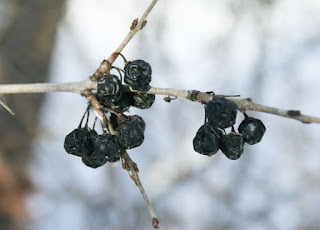 |
| A female Buckthorn displays a persistent leaf, fruits and terminal thorn that help with winter identification. |
For an explanation of the terms used here, see a previous post, “How to Identify Deciduous Trees and Shrubs in Winter.” A two-page guide to Buckthorn ID is free to download.
Common Buckthorn, Rhamnus cathartica, is an invasive shrub or small tree that was introduced to the U.S. in the late 1700s as an ornamental and a hedge plant. Thanks to its prolific fruit production, it soon spread to a range of habitats, from forests and savannas to prairies and wetland edges. According to Bell Museum herbarium records, it has been present in Minnesota since at least 1937, when it was found at a barge terminal on the Mississippi River in Minneapolis.
This aggressive species degrades habitat in many ways. Typical of many invasive plants, established stands of Buckthorn shade out native species and reduce diversity. Their nitrogen-rich leaves are quickly consumed by soil invertebrates, including invasive earthworms that deplete the duff layer of organic matter. The resulting bare, mineral soils erode more easily and are more quickly colonized by additional Buckthorn or other invasive plants, such as Garlic Mustard (Alliaria petiolata). |
| Everything green in this understory is Common Buckthorn. The photo was taken in November. |
Because Buckthorn retains its leaves late into fall, it is easy to recognize by the green layer it forms under a leafless canopy. Even after it sheds its leaves, however, there are easy ways to recognize this species. In fact, winter can be an ideal time to map and manage Buckthorn. This post shows how to identify the plant by its twigs, buds, bark and fruits.
“Buckthorn” Describes the Ends of the Twigs
Bark is Warty to Flaky with an Orange Inner Layer
Females Have Blue-Black Fruits – Lots of Them
Buckthorn Look-alikes
Glossy Buckthorn (Frangula alnus), another invasive,
prefers wetter habitats than common buckthorn. Its twigs are not tipped with thorns. Buds are alternate and in winter are covered by rust-colored hairs rather than scales. Bark of younger trunks is speckled. Inner bark is yellow.
Alder-leaved Buckthorn (Rhamnus alnifolia), a native shrub typically found in moist or wet soils in forested parts of Minnesota, rarely reaches more than 3 feet tall, and its stems are typically no more than 1 inch in diameter (Smith 2008). Its buds are clearly alternate and lack thorns.
References
Buckthorn.
Minnesota DNR. Website accessed January 12, 2021.
Buckthorn
Management. Minnesota DNR. Website accessed January 12, 2021.
Buckthorn: What You Should Know, What You Can Do. Minnesota DNR. Guide EWR_395_17. (This is formatted as a printable guide. )
Common
Buckthorn. University of Minnesota Extension Service. Website accessed January 12,
2021.
Common
Buckthorn. Woody Invasives of the Great Lakes Collaborative. Website
accessed January 14, 2021.
Common
or European Buckthorn. Minnesota Department of Agriculture. Website
accessed January 12, 2021.
Winter
Control of Buckthorn (video). University of Minnesota Extension Service.
December 2013.
Smith, W.R. 2008. Trees and Shrubs of Minnesota. University
of Minnesota Press, Minneapolis.







